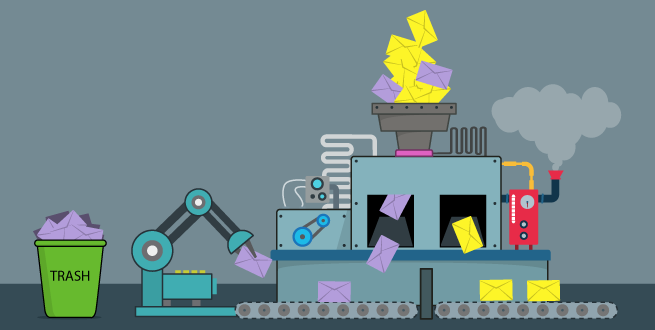Changes announced in Gmail and Outlook point to the relevance
Published in august, 21 of 2015
Between late July and early August, Google announced that it would begin using an “artificial neural network” to better identify who are the users of Gmail that make spam. Shortly thereafter, Microsoft joined the same idea and issued a similar function called “Clutter”.
If you don’t know these terms, don’t worry, we are here to show what really matters for you in this change, which impact can be generate on your email marketing campaigns.
What are these changes in Gmail and Outlook?
Let's start with Microsoft! Although it was reported earlier, the “Clutter’ already exists indeed. It’s a feature that can be found on the web version of Outlook and Office 365. The difference with the recently released option is that it will be enabled by default in your Outlook Web and Office 2016 onwards.
When you activate it, you have access to the content of your emails and reading habits. This way, you can identify which content is relevant and which one is not. All considered not relevant will be forwarded to a folder called “Clutter”.
Now it's Google’s turn! It’s "neural network" has the same goal: identify content that requires responses or actions by the user without the need to be marked as spam. This identification will be done by the system itself.
Your inbox will only count with emails that have not been answered, unread messages or emails with frequent interactions.
What does this mean for email marketing?
At first glance, it appears that these features of Gmail and Outlook for relevance create a new limbo of emails, like a trash 2.0 in the same way that Google's email inbox is divided into tabs (especially in the case of Clutter that creates a new folder in your account, which stores all content considered not relevant).
Most likely, this is the principle, but there is a fundamental difference from the Google tabs and junk mail. Both the feature in Gmail as in Outlook serve to identify what is relevant or not automatically, taking into account the level of interaction with the sender. Reputation, content, everything is evaluated to be marked as spam or not spam.
In the case of Google, for example, the “neural network” will measure the frequency that the content is marked as spam, in addition to interactions or the lack them. This can therefore accurately determine if your email marketing campaign is spam or not.
Besides, you can also evaluate the habits of each user individually. If you have a reader who signed up to receive your weekly newsletter, but only reads the content effectively once a month, you can adapt.
What should you do?
Both functions are giving real importance to the concept of relevance, not just enough to have a content with a score of 0.0 by SpamAssassin, active validation and a healthy reputation.
It’s important to generate relevant content and on the frequency chosen by the user, plus a willingness to adapt daily. For this you should know the same as the “neural network” of Google, but before it. Here's how this is possible:
- Identify the different generated content (newsletters, promotional emails, transactional emails);
- Segment your lists according to the preferences of its members;
- Give option for your reader to choose the frequency of emails, with the possibility of change;
- Follow the reports to identify changes and be ready to adapt;
- Set all necessary validations, increasing the security of your campaigns.
Conclusion
Every change can be well enjoyed if you know how to use it to your advantage. And that goes too for email marketing campaigns. If you act in the area, follow all the trends for technology and digital marketing and try to apply the most the best email practices. This way, you will only gain relevance by offering content that really matters and frequency that will let your recipient interested in receiving what you have to give.
Did you like it? Share!
Meet us at social networks and take the reading forward!
Facebook, Twitter, LinkedIn, Google+
Do you have any questions about the platform or suggestions for our blog? Send it to us through the comments!